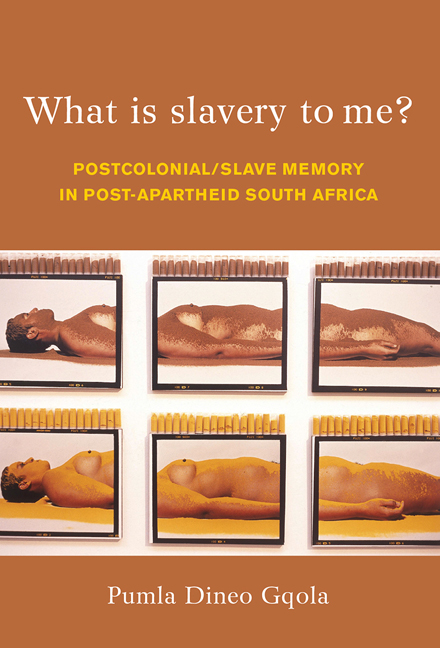Book contents
- Frontmatter
- Contents
- Dedication
- Acknowledgements
- Acronyms
- Introduction: Tracing (re)memory, thinking through echoes of colonial slavery in contemporary South Africa
- 1 Remembering differently: repositioned coloured identities in a democracy
- 2 (Not) Representing Sarah Bartmann
- 3 Whiteness remixed, or remembered impurity, shame and television
- 4 ‘As a slave you have to have faith or you'll give up’: Cape Malay/Muslim identity clusters in Cape Town
- 5 ‘Is the secret in cooking?’ Coded food, spice routes and processing Malay identities
- Conclusion: Unshackling memory, rememorying agency
- Endnotes
- References
- Index
Introduction: Tracing (re)memory, thinking through echoes of colonial slavery in contemporary South Africa
Published online by Cambridge University Press: 21 April 2018
- Frontmatter
- Contents
- Dedication
- Acknowledgements
- Acronyms
- Introduction: Tracing (re)memory, thinking through echoes of colonial slavery in contemporary South Africa
- 1 Remembering differently: repositioned coloured identities in a democracy
- 2 (Not) Representing Sarah Bartmann
- 3 Whiteness remixed, or remembered impurity, shame and television
- 4 ‘As a slave you have to have faith or you'll give up’: Cape Malay/Muslim identity clusters in Cape Town
- 5 ‘Is the secret in cooking?’ Coded food, spice routes and processing Malay identities
- Conclusion: Unshackling memory, rememorying agency
- Endnotes
- References
- Index
Summary
Meaning is constructed out of [a] multiplicity of voices and positions.
(Boyce Davies 1994: 162)When they ask of you tomorrow
I will tell them that you are alive
everywhere inside of me
especially where I love myself
more than you did
where I love myself
almost as much as you did
(Mashile 2008: ll. 25–31)I have a multiple identity. There is no crisis. There is a kind of delight as well as a kind of anguish in jumping from one identity to the next. It's like electrons which have their own energization circles. Sometimes they jump from one to the next and release an enormous amount of energy; then jump back to another circle: little electrons jumping. That is not a crisis. That is a delight and poignancy, and hopefully a release of energy.
(Dabydeen in Birbalsing 1997: 195)This book goes to print on the eve of South Africa's sixteenth democratic anniversary. What is Slavery to Me? examines how the South African imagination conceives of, constructs and interprets itself at a time of transition, and how slavery is evoked and remembered as part of negotiating current ways of being. The new dispensation came to symbolise the promise of freedom and multiple beginnings: individually and collectively, 27 April 1994 was an invitation to envision ourselves differently than we had up until that point.
The three quotations with which I begin this chapter, and book, capture some of the complexities that accompany being invited to imagine ourselves anew. Carole Boyce Davies conceives of meaning as weaving together layers and moving targets at the same time, something she also refers to as ‘migratory subjectivities’. Rhyming with Boyce Davies, the extract from Lebogang Mashile shows how a sense of self is shaped from dealing with abstraction and remnants in the psyche which ensure that yesterday lives in tomorrow, whilst the fantasy of the future shapes what is possible today. Finally, David Dabydeen's statement stresses the work inherent in identity: energetic, creative, playful and difficult at the same time.
- Type
- Chapter
- Information
- What is Slavery to Me?Postcolonial/Slave Memory In Post-Apartheid South Africa, pp. 1 - 20Publisher: Wits University PressPrint publication year: 2010



